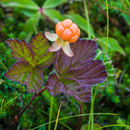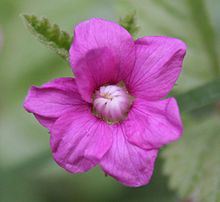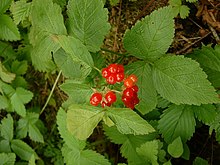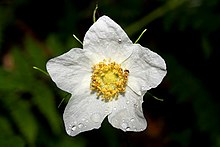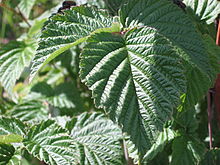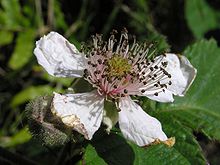Associations
provided by BioImages, the virtual fieldguide, UK
Foodplant / gall
Agrobacterium tumefaciens causes gall of stem (esp. base) of Rubus
Foodplant / miner
solitary larva of Agromyza potentillae mines leaf of Rubus
Foodplant / miner
larva of Agromyza sulfuriceps mines leaf of Rubus
Other: major host/prey
Plant / hibernates / within
naked prepupa of Allantus calceatus hibernates inside hollow stem of Rubus
Plant / hibernates / within
naked prepupa of Allantus rufocinctus hibernates inside hollow twig of Rubus
Foodplant / gall
solitary, hypophyllous Amphorophora rubi causes gall of live, curled leaf of Rubus
Foodplant / gall
larva of Anthonomus rubi causes gall of flower bud of Rubus
Other: major host/prey
Foodplant / sap sucker
hypophyllous Aphis ruborum sucks sap of live leaf of Rubus
Foodplant / open feeder
larva of Arge cyanocrocea grazes on leaf of Rubus
Other: sole host/prey
In Great Britain and/or Ireland:
Foodplant / pathogen
Armillaria mellea s.l. infects and damages Rubus
Foodplant / open feeder
imago of Batophila aerata grazes on leaf of Rubus
Foodplant / open feeder
imago of Batophila rubi grazes on leaf of Rubus
Foodplant / saprobe
stalked apothecium of Betulina fuscostipitata is saprobic on dead leaf of Rubus
Remarks: season: 7-10
Foodplant / saprobe
sclerotium of Botryotinia fuckeliana is saprobic on debris of Rubus
Foodplant / saprobe
subiculate pseudothecia of Byssolophis sphaerioides is saprobic on Rubus
Foodplant / open feeder
epiphyllous larva of Caliroa cerasi grazes on leaf of Rubus
Remarks: season: 6-9
Foodplant / saprobe
erumpent, subsessile apothecium of Calycellina populina is saprobic on dead, fallen leaf of Rubus
Remarks: season: 9-3
Foodplant / saprobe
effuse colony of Camposporium dematiaceous anamorph of Camposporium cambrense is saprobic on litter of Rubus
Remarks: season: 1-12
Foodplant / saprobe
effuse colony of Camposporium dematiaceous anamorph of Camposporium pellucidum is saprobic on litter of Rubus
Foodplant / saprobe
solitary or in small groups, erumpent bcoming more or less superficial ascocarp of Capronia pleiospora is saprobic on rotten wood of Rubus
Foodplant / saprobe
perithecium of Chaetosphaeria myriocarpa is saprobic on fallen, dead branch of Rubus
Remarks: season: 1-12
Foodplant / saprobe
colony of Chalara dematiaceous anamorph of Chalara aotearoa is saprobic on dead Rubus
Foodplant / open feeder
larva of Claremontia alternipes grazes on leaf of Rubus
Remarks: Other: uncertain
Foodplant / sap sucker
adult of Compsidolon salicellus sucks sap of Rubus
Remarks: season: 7-10
Foodplant / gall
larva of Contarinia rubicola causes gall of flower bud of Rubus
Other: sole host/prey
Foodplant / saprobe
effuse colony of Coremiella dematiaceous anamorph of Coremiella cubispora is saprobic on Rubus
Remarks: season: 7-10
Foodplant / saprobe
fruitbody of Crepidotus cesatii is saprobic on decayed, dead stem of Rubus
Foodplant / saprobe
sporodochium of Cryptocoryneum dematiaceous anamorph of Cryptocoryneum rilstonii is saprobic on dead branch of Rubus
Foodplant / saprobe
embedded stroma of Cryptodiscus rhopaloides is saprobic on dead branch of Rubus
Remarks: season: 6-11
Foodplant / gall
larva of Dasineura plicatrix causes gall of leaf of Rubus
Foodplant / saprobe
immersed, often loosely grouped perithecium of Diaporthe eres is saprobic on wood of Rubus
Foodplant / saprobe
immersed perithecium of Diaporthe pardalota is saprobic on dead wood of Rubus
Remarks: season: 1-8
Foodplant / saprobe
immersed perithecium of Diaporthe rudis is saprobic on wood of Rubus
Foodplant / gall
larva of Diastrophus rubi causes gall of root of Rubus
Foodplant / saprobe
effuse colony of Dictyosporium dematiaceous anamorph of Dictyosporium toruloides is saprobic on rotten wood of Rubus
Remarks: season: 1-12
Foodplant / pathogen
immersed pseudothecium of Didymella applanata infects and damages live leaf of Rubus
Remarks: season: 3-5
Foodplant / gall
Eriophyes gibbosus causes gall of leaf of Rubus
Foodplant / gall
Eriophyes rubicolens causes gall of leaf of Rubus
Foodplant / gall
Eriophyes silvicola causes gall of leaf of Rubus
Foodplant / saprobe
immersed, stromatic perithecium of Eutypella scoparia is saprobic on dead branch of Rubus
Remarks: season: 1-4
Foodplant / saprobe
sometimes effuse Gliocladium anamorph of Gliocladium roseum is saprobic on dead branch of Rubus
Other: major host/prey
Foodplant / internal feeder
larva of Gracilia minuta feeds within dead, dry wood (stem) of Rubus
Foodplant / saprobe
sessile apothecium of Graddonidiscus coruscatus is saprobic on leaf? of Rubus
Remarks: season: 10-12
Foodplant / pathogen
immersed pycnidium of Hapalosphaeria coelomycetous anamorph of Hapalosphaeria deformans infects and damages live anther of Rubus
Foodplant / saprobe
clustered, subiculate pseudothecium of Herpotrichia macrotricha is saprobic on fallen branch of Rubus
Remarks: season: 10-4
Other: minor host/prey
Foodplant / saprobe
apothecium of Hymenoscyphus albopunctus is saprobic on rotting leaf of Rubus
Remarks: season: 10-11
Foodplant / saprobe
stalked apothecium of Hymenoscyphus calyculus is saprobic on dead, fallen branch of Rubus
Remarks: season: 6-12
Foodplant / saprobe
sessile or subsessile apothecium of Hymenoscyphus epiphyllus is saprobic on litter of Rubus
Remarks: season: 9-11
Foodplant / saprobe
superficial stroma of Hypocrea splendens is saprobic on dead branch of Rubus
Remarks: season: 9-10
Foodplant / saprobe
hysterothecium of Hysterium angustatum is saprobic on dead, decorticate branch of Rubus
Remarks: season: 3-5
Foodplant / saprobe
sessile or subsessile apothecium of Lachnum misellum is saprobic on damp, dead, fallen, densely shaded leaf of Rubus
Remarks: season: 9-10
Foodplant / gall
larva of Lasioptera rubi causes gall of stem of Rubus
Foodplant / saprobe
superficial, gregarious perithecium of Lasiosphaeria caudata is saprobic on dead branch of Rubus
Remarks: season: 7-8
Foodplant / saprobe
superficial perithecium of Lasiosphaeria ovina is saprobic on Armillaria mellea-decayed wood of Rubus
Remarks: season: 9-4
Foodplant / saprobe
usually immersed pseudothecium of Lophiostoma compressum is saprobic on decorticate wood of Rubus
Remarks: season: 10-2
Foodplant / open feeder
nocturnal larva of Macrophya montana grazes on leaf of Rubus
Foodplant / sap sucker
Macropsis fuscula sucks sap of live leaf of Rubus
Foodplant / sap sucker
Macropsis scotti sucks sap of live leaf of Rubus
Foodplant / sap sucker
Macrosiphum funestum sucks sap of Rubus
Foodplant / saprobe
superficial, often in very large clusters pseudothecium of Melanomma pulvis-pyrius is saprobic on dry, hard, decorticate branch wood of Rubus
Remarks: season: 9-5
Foodplant / saprobe
colony of Gonytrichum dematiaceous anamorph of Melanopsammella inaequalis is saprobic on fallen, dead branch of Rubus
Remarks: season: 1-12
Foodplant / saprobe
colony of Chloridium dematiaceous anamorph of Melanopsammella preussii is saprobic on fallen, dead branch of Rubus
Remarks: season: 11-5
Foodplant / saprobe
colony of Menispora dematiaceous anamorph of Menispora ciliata is saprobic on dead wood of Rubus
Foodplant / saprobe
superficial mycelium of Microthyrium ciliatum var. hederae is saprobic on dead leaf of Rubus
Remarks: season: 9-5
Foodplant / saprobe
sessile apothecium of Mollisia cinerea is saprobic on dead wood of Rubus
Remarks: season: 1-12
Foodplant / saprobe
sessile apothecium of Mollisia melaleuca is saprobic on dead wood of Rubus
Remarks: season: 10-5
Foodplant / saprobe
apothecium of Mollisina acerina is saprobic on leaf-litter of Rubus
Foodplant / open feeder
larva of Monophadnoides geniculatus grazes on leaf of Rubus
Foodplant / saprobe
erumpent stroma of Nectria coccinea is saprobic on dead trunk of Rubus
Remarks: season: 9-5
Foodplant / parasite
Ovularia anamorph of Ovularia rubi parasitises live leaf of Rubus
Foodplant / internal feeder
larva of Pegomya rubivora feeds within live shoot tip of Rubus
Plant / associate
imago of Perineura rubi is associated with Rubus
Foodplant / saprobe
erumpent, clustered, short-stalked apothecium of Pezizella vulgaris is saprobic on dead twig of Rubus
Remarks: season: 7-12
Foodplant / saprobe
effuse colony of Phaeoisaria dematiaceous anamorph of Phaeoisaria clematidis is saprobic on fallen, dead branch of Rubus
Remarks: season: 11-4
Foodplant / saprobe
colony of Phaeostalagmus dematiaceous anamorph of Phaeostalagmus cyclosporus is saprobic on fallen, dead branch of Rubus
Remarks: season: 1-12
Foodplant / saprobe
colony of Phaeostalagmus dematiaceous anamorph of Phaeostalagmus tenuissimus is saprobic on litter of Rubus
Foodplant / parasite
hypophyllous telium of Phragmidium rubi-idaei parasitises leaf of Rubus
Remarks: season: 5-10
Foodplant / saprobe
effuse colony of Phragmocephala dematiaceous anamorph of Phragmocephala elliptica is saprobic on dead branch of Rubus
Remarks: season: 4-10
Foodplant / gall
Phyllocoptes gracilis causes gall of leaf of Rubus
Foodplant / saprobe
apothecium of Plectania melastoma is saprobic on dead, half-buried stem of Rubus
Remarks: season: 1-6,12
Foodplant / open feeder
larva of Priophorus brullei grazes on leaf of Rubus
Foodplant / open feeder
larva of Pristiphora pallidiventris grazes on leaf of Rubus
Foodplant / sap sucker
Pseudaulacaspis pentagona sucks sap of thickly encrusted branch (old) of Rubus
Foodplant / saprobe
fruitbody of Resinomycena saccharifera is saprobic on dead, decayed stem of Rubus
Foodplant / internal feeder
larva of Rhynchites germanicus feeds within decaying stolon of Rubus
Foodplant / saprobe
colony of Geniculosporium dematiaceous anamorph of Rosellinia aquila is saprobic on dead branch of Rubus
Remarks: season: 2-5
Foodplant / gall
Rubus Stunt phytoplasma causes gall of stem of Rubus
Foodplant / sap sucker
Sitobion fragariae sucks sap of live leaf of Rubus
Other: minor host/prey
Foodplant / saprobe
effuse colony of Sporidesmiella dematiaceous anamorph of Sporidesmiella hyalosperma var. hyalosperma is saprobic on dead branch of Rubus
Remarks: season: 2-10
Foodplant / saprobe
effuse colony of Sporidesmium dematiaceous anamorph of Sporidesmium goidanichii is saprobic on dead leaf of Rubus
Plant / associate
imago of Sterictophora furcata is associated with Rubus
Foodplant / saprobe
effuse colony of Pseudospiropes dematiaceous anamorph of Strossmayeria atriseda is saprobic on dead bark of Rubus
Foodplant / visitor
imago of Trichius fasciatus visits for nectar and/or pollen flower of Rubus
Foodplant / saprobe
apothecium of Unguiculella foliicola is saprobic on dead, fallen leaf of Rubus
Remarks: season: 6-12
Foodplant / saprobe
immersed, grouped in circles perithecium of Valsa ambiens is saprobic on branch of Rubus
Remarks: season: 10-5
Foodplant / saprobe
immersed, in groups of about 10 perithecium of Valsa ceratosperma is saprobic on branch of Rubus
Remarks: season: 11-3
Plant / associate
effuse colony of Veronaea dematiaceous anamorph of Veronaea parvispora is associated with Rubus
Foodplant / saprobe
effuse colony of Virgaria dematiaceous anamorph of Virgaria nigra is saprobic on bark of Rubus
Brief Summary
provided by EOL authors
Rubus, the bramble or bramble genus, consists of around 700 species of usually woody and deciduous shrubs or trailing shrubs, but occasionally perennial herbs, in the Rosaceae (rose family), particularly abundant in the temperate regions of the northern hemisphere. The genus is the source of numerous widely cultivated species and varieties of berries, among them: blackberries (R. fruticosus is frequently cultivated, while R. allegheniensis is a widespread wild species in North America); raspberries (R. idaeus is the source of many commercial varieties, but the black raspberry, R. occidentalis, is commonly gathered in the wild in North America, and has been the source of some cultivars); cloudberries (R. chamaemorus), which are restricted to cold temperate climes bordering the Arctic, but are commercially harvested in Sweden, Norway, and Denmark; dewberries (R. flagellaris and others); wineberries (R. phoenicolasius), native to China and Japan; veitchberries (R. ulmifolius); and various complex hybrids, including loganberries (var. loganobaccus, which originated as a cross between R. fruticosus and R. idaeus); boysenberries (likely a backcross between loganberry and one of its parent species); tayberries (probably from R. ulmifolius, R. vitifolius, and R. allegheniensis); and hildaberries (a hybrid of boysenberries and tayberries). In addition to cultivated fruits, the genus also has a number of species that are grown as ornamentals, for their flowers or foliage. Although Rubus includes many cultivated berry species, other commonly cultivated berries that do NOT belong to this genus are strawberries (Fragaria spp., also in the Rosaceae), blueberries cranberries, and lingonberries (Vaccinium spp., in the Ericaceae); huckleberries (Gaylusaccia species, in the Ericaceae), and gooseberries (Ribes species, related to currants, in the Grossulariaceae or Saxifragaceae). Rubus species are botanically complex and often difficult to classify, as many species readily hybridize readily, and they are also characterized by apomixis (asexual reproduction), which leads to the persistence of many clonal lines that may appear to be separate species. Among this large group of species there is considerable variation in form, but in general they have erect, climbing, arching, or prostrate stems, in most species woody although herbaceous in a few; stems may be hairy or glabrous (smooth) or sometimes glaucous (waxy), and usually with prickles or bristles (hence the common name, brambles). The leaves are alternate and usually palmately or pinnately compound but occasionally simple, often toothed; leaves may be glabrous or hairy, sometimes with bristles or glandular hairs. Most Rubus species are biennials, with first year canes (primocanes) that have leaves only, while flowers and fruit develop on the second-year canes (floricanes). Leaf characters may vary from first to second year, which further complicates species recognition and classification. Flowers, which are usually bisexual, are white, pink, or red, generally with 5 petals, and often occur in clusters but are occasionally solitary. The fruit is not botanically a berry, but is an aggregate of drupes or achenes—a compound fruit that develops from a single flower and composed of many smaller drupes (fleshy pulp surrounding a hard seed) or achenes (small, hard-coated fruits with skins that do not split open to reveal the seed when mature). The drupelets or achenes are aggregated on semispherical, conical, or cylindrical torus-shaped receptacle, from which the fruit may separate when it is picked or falls, leaving behind a hollow (as in raspberries); or the receptacle may remain attached to the fruit (as in blackberries). (Bailey et al. 1976, FAOSTAT 2012, Flora of China Hedrick 1919, Martin et al. 1951, Michigan Flora Online 2011, van Wyk 2005.)
General Ecology
provided by EOL authors
Rubus species are found in a diverse range of ecosystems, and provide food for numerous species of birds (at least 97 species in North America), mammals (at least 28 species, ranging from small mammals to fur species to hoofed browsers), and insects. (Martin et al. 1951.)
Cultural and economic importance
provided by EOL authors
Many Rubus species were important food sources for native peoples of the Northern Hemisphere, who used the fruits and, in some species, the leaves, stems or roots; the berries were also used as a source of dye. The economic importance of this diverse group is hard to assess, as there are so many different species, but the FAO estimates that the total commercial production of raspberries and other berries (not specified, but not including blueberries, cranberries, gooseberries, or strawberries) was 1.4 million metric tons, harvested from 223,190 hectares worldwide. However, this undoubtedly understates the numerous berries produced for local markets and in home gardens. (Bailey et al. 1976, FAOSTAT 2012.)
Molecular Phylogeny
provided by EOL authors
Alice and Campell used the nuclear internal transcribed spacer (ITS) to build a phylogeny of Rubus. The dataset was comprised of 57 species from 12 subgenera.
Phylogeny of Rubus (rosaceae) based on nuclear ribosomal DNA internal transcribed spacer region sequences, Am. J. Bot., January 1999, vol. 86, no. 1, 81-97
Yang et al. investigated the phylogeny of about 20 species with distributions in east Asian. The authors focused on the subgenera Idaeobatus (14 species). Sequence data of the second intron of the nuclear gene (LEAFY) as well as data from a prevoius study (Yang and Pak 2006) from the nuclear internal transcribed spacer (ITS) and a the plastid intergenic spacer trnL-F was used for analysis.
Phylogeny of Korean Rubus (Rosaceae) based on the second intron of the LEAFY gene,Canadian Journal of Plant Science, 2012, 92(3): 461-472
Phylogeny of Korean Rubus (Rosaceae) based on ITS(nrDNA) and trnL/F intergenic region (cpDNA), Yang and Pak, J. Plant Biol, 2006, 49: 44-54
Description
provided by Flora of Zimbabwe
Shrubs. Stems prickly, scrambling or trailing. Stipules free or
adnate to base of petiole. Leaves 3-foliolate or imparipinnate with 2-3(-4) pairs of leaflets; upper leaves sometimes simple; leaflets serrate. Flowers in many-flowered racemose or paniculate inflorescences at the ends of the branches. Flowers bisexual,
usually 5-merous, actinomorphic. Calyx segments 5. Petals 5, sometimes 0. Stamens numerous. Carpels many. Fruit
a head of many 1-seeded drupelets.
- license
- cc-by-nc
- copyright
- Mark Hyde, Bart Wursten and Petra Ballings
- bibliographic citation
- Hyde, M.A., Wursten, B.T. and Ballings, P. (2002-2014). Rubus Flora of Zimbabwe website. Accessed 28 August 2014 at http://www.zimbabweflora.co.zw/speciesdata/genus.php?genus_id=654
- author
- Mark Hyde
- author
- Bart Wursten
- author
- Petra Ballings
Rubus: Brief Summary
provided by wikipedia EN
Rubus is a large and diverse genus of flowering plants in the rose family, Rosaceae, subfamily Rosoideae, with over 1,350 species.
Raspberries, blackberries, and dewberries are common, widely distributed members of the genus, and bristleberries are endemic to North America. Most of these plants have woody stems with prickles like roses; spines, bristles, and gland-tipped hairs are also common in the genus. The Rubus fruit, sometimes called a bramble fruit, is an aggregate of drupelets. The term "cane fruit" or "cane berry" applies to any Rubus species or hybrid which is commonly grown with supports such as wires or canes, including raspberries, blackberries, and hybrids such as loganberry, boysenberry, marionberry and tayberry. The stems of such plants are also referred to as canes.
- license
- cc-by-sa-3.0
- copyright
- Wikipedia authors and editors

